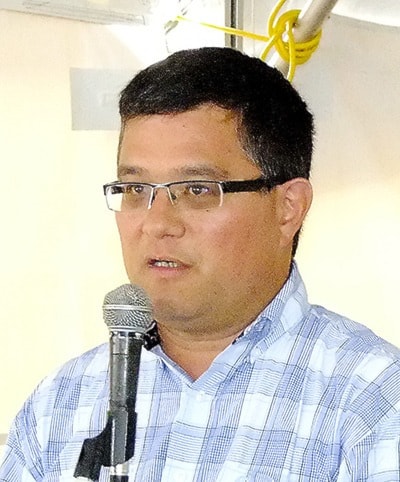World demand for beef is going to continue to grow and improvements in feed efficiency will help growers meet that demand.
Those were a couple of the conclusions Kee Jim gave during a talk at the Thompson Valley Hereford Breeders annual Field Day and Junior Show held Saturday in Little Fort.
A veterinarian, a resident of Okotoks, and one of the four sons of Gung Loy Jim, Kee Jim is generally regarded as one of Canada’s foremost experts on feedlots and the cattle industry.
The last 25 years have seen the greatest growth of affluence in world history, he pointed out.
“I’m pretty bullish about the future,” he said. “As people get more money, they have fewer children, and they eat more beef.”
Pork is presently one-third the price of beef but most people still prefer beef.
“It’s a very unique tasting protein,” he said.
The cattle herds in Canada and the U.S. are at their lowest points since the 1950s.
Demand in North America is static or going down slightly, but is more than matched by increasing demand from the rest of the world.
Canada presently exports 50 per cent of its beef production. About 80 per cent of that goes to the United States, but that is only because of our incompetence in marketing, Jim said.
Today there are only 300,000 beef cattle in Russia, compared to nearly four million in Canada.
“One company owns half those cows,” he said. “It’s imported them over the past three years.”
One possible difficulty was a recent announcement by Tyson Foods that it will no longer accept cattle fed with Zilmax.
This is significant because Tyson is one of three packers that butcher nearly all the cattle in the U.S.
The additive increases the feed efficiency dramatically and is typically fed during the last 21 days.
The Tyson announcement was due to pressure from China and Russia, said Jim.
Jim found it ironic, because China and Russia have such poor food safety records.
Jim predicted that the feedlot industry will continue to consolidate into fewer and larger players.
The cow/calf industry, on the other hand, will continue to be dominated by independent operators. There are too many local variables in a cow/calf operation for there to be successful economies of scale, he felt.
Studies improve feed efficiency, and feed efficiency is one of the most economically important traits of cattle for the cow/calf and feedlot industries but, until recently, it has been difficult or impossible to measure, Jim said.
Historically, cattle have been selected for breeding based on what they looked like and how much weight they gained.
How much feed they needed to gain that weight has not been a factor – even though it can make a tremendous difference in profitability.
According to Jim, a feed efficiency rate of 6:1 versus 7:1 can mean a difference of 13.5 cents per pound or $81 per head (the number 6:1 means six pounds of feed produces one pound of cow).
“Some cattle have feed efficiencies of 5:1 while others have 8:1, but you are not able to visually see any difference,” he said.
Last fall the Canadian Hereford Breeders Association began a trial with 325 bulls to test their feed efficiencies.
Little Fort Herefords is doing its own trial using heifers and bulls, with data to go to the national body. Each animal has its own radio marker that allows a record to be kept of exactly how much it eats.
“We hope to find the genetic markers for feed efficiency,” said Jim. “I think this a fairly significant breakthrough in cattle breeding.”
He pointed out that high efficiency can’t be the only trait selected for. However, new technology now allows it to be accurately measured for the first time.
